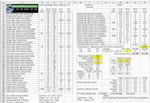PV module manufacturers are expected to see record revenues next year as the recovery for the industry that has been gathering pace in the last 18 months reaches its peak, according to IHS.
Figures from the market research firm’s Module Intelligence Service indicate that module revenues will hit a record US$41.9 billion in 2016, exceeding the previous record set in 2010 by 4%.
Strong demand in a number of markets, a stable pricing environment and a fresh wave of new capacity expansions have all created favourable conditions for module manufacturers after several years of intesnse competition, IHS said.
In the final quarter of 2015, module shipments are expected to rise 29% year over year to 18.7GW in the quarter.
That growth is expected to continue into 2016, when total module shipments are expected to exceed those seen in 2015 by 10%, according to IHS.
“Compared to prior years, this period of strong growth in solar installation demand, coupled with tight supply, will support relatively robust pricing,” said Edurne Zoco, senior principal analyst for IHS Technology. “In fact average annual prices are forecast to decline significantly less than in previous years.”
But after 2016, PV’s growth trajectory looks less positive, with a slowdown in global demand for modules expected, and a consequential drop in module prices of around 9%. IHS said one of the factors contributing to this scenario is the likely decline in the US market in 2017 if the reduction in the federal investment tax credit goes ahead as planned at the start of that year.
“This year and next year will mark a climax in the recovery of the solar PV sector, after a period of intense price reductions and margin compression, when average gross margins fell into the mid single digits or lower,” Zoco said.
“Even so, the predicted slowdown in global demand in 2017 – on the back of a decline in the United States – is likely to challenge these suppliers once again, since manufacturing capacity additions are set to dangerously outpace industry demand. Competition will intensify, which will lead to accelerating declines in prices and gross margins, for the first time since 2012.”
- Home
- Blog
- Forum
- Green Home Topics

- »Healthy Home
- »Water Conservation
- »Energy Efficiency
- »Materials & Products
- »Resources
- Videos
- »From the Experts
- Remodeling with Passive House Approach
- How to Choose an Advanced Water Heater
- Choosing A Whole-House Ventilation System
- Selecting High Performance Windows
- Toward Zero Energy at Home - A Personal Example
- Remodel to Passive House Standards
- An Introduction to Ecological Landscaping
- Weingarten House at San Benancio - Energy
- A Deep Energy Retrofit Project
- Directory
- Events/News

- Shop
- About Us





